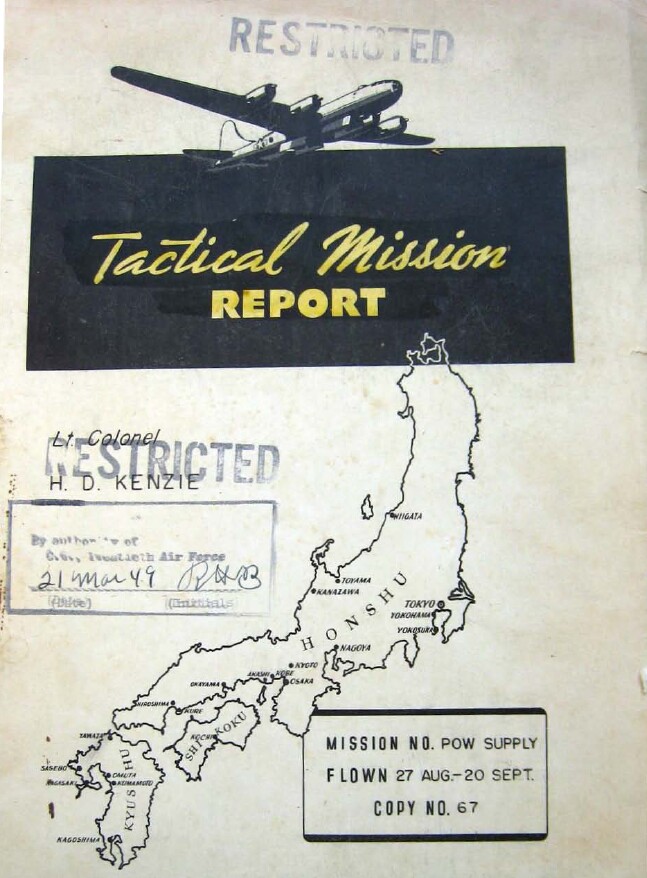
HEADQUARTERS
|
|||||||||||||||||||||||||||||||||||||||||||||||||||||||||||||||||||||||||||||||||||||||||||||||||||||||||||||||||||||||||||||||||||||||||||||||||||||||||||||||||||||||||||||||||||||||||||||||||||||||||||||||||||||||||||||||||||||||||||||||||||||||||||||||||||||||||||||||||||||||||||||||||||||||||||||||||||||||||||||||||||||||||||||||||||||||||||||||||||||||||||||||||||||||||||||||||||||||||||||||||||||||||||||||||||||||||||||||||||||||||||||
HAKODATE-
|
TOKYO |
NAGOYA |
OSAKA |
HIROSHIMA |
FUKUOKA |
FOREWARD
This report covers the Prisoner of War Supply Missions that were executed by the Twentieth Air Force from 27 August to 20 September 1945.
TABLE OF CONTENTS
Tactical Narrative
Annex A - Maps of POW Camp Locations
Annex B - Names and Population Estimates of POW Camps to which Missions were Conducted
Annex C - Air-Sea Rescue Chart
Annex D - Strike Photographs and Assessment Reports of Supply Missions
Annex E - Statistical Summary
Annex F - Specimen of Wing Field Order
Annex G - Photograph of Aircraft Markings
Annex H - Distribution
Prepared by:
A-2 Section
Twentieth Air Force
C O N F I D E N T I A L
HEADQUARTERS TWENTIETH AIR FORCE
APO 234, c/o Postmaster
San Francisco, California
SUBJECT: Report of Prisoners of War Supply Missions from 27 August to 20 September 1945.
TO: Commanding General, United States Army Strategic Air Forces, APO 234, c/o Postmaster, San Francisco, California.
1. STRATEGY AND PLANNING OF OPERATIONS:
a. Strategy:
(1) The confirmation of the Japanese surrender on 15 August 1945, presented to the Allied nations the difficult task of supplying Japanese-held prisoners of war and civilian internees with food, clothing and medical supplies until they could be evacuated by occupation forces. A large number of prisoners were known to be in Japanese camps and the reported conditions of starvation rations, disease and maltreatment made relief measures particularly urgent. It was estimated that the time that would be required for evacuation of the prisoners would be 30 days and it was believed that many lives could be saved by prompt and adequate supply of the known camps.
(2) Air transport was chosen as the most feasible method of providing the supplies necessary. The original plan was that Far East Air Forces aircraft, based on Okinawa and the Philippines, would share the air-supply task with Marianas-based B-29's. Later the entire project was assigned to the Twentieth Air Force and presented many far-reaching problems.
b. Planning:
(1) Because of the nature of this project it was decided that only general planning would be done at Twentieth Air Force Headquarters. Specific planning on routes, loading, dates of missions, etc., was to be done by the Wings engaged in the operations.
(2) An original and important factor in planning these operations was the availability of food, medical supplies and cargo parachutes. It was obvious that, if the Twentieth Air Force were to carry out the supply drops with the necessary dispatch, all supplies must be packaged and made available in the Marianas. The food and medical supply requirements for the program were set up on a basis of 30 days' supply for 69,000 people. Arrangements were made through the Western Pacific Base Command whereby all supplies were to be made available at Saipan. This was made possible by borrowing on stores and provisions which had been accumulated for the planned invasion of Japan. Of the 63,000 cargo parachutes required for the project, there were only 11,000 in the Marianas. This made it necessary to air-lift all available cargo parachutes from the Philippines to the Marianas.
(3) After determining where and in what quantities the necessary supplies could be delivered for loading, it was necessary to conduct dropping tests in order to make detailed plans for the operations of the aircraft. Loading and dropping tests were conducted by the Operational Engineering Section of the Twentieth Air Force. Because of space limitations it was found that a 10,000 pound load, consisting of 40 individual drop units, was the capacity of a B-29. The best altitude for dropping was found to be between 500 and 1000 feet and the best speed approximately 165 miles per hour. To facilitate identification it was decided that all aircraft engaged in these operations would be marked "PW Supplies" in letters three feet high under each wing, the marking to extend from wing tip to the outside engine nacelle. (See Annex G.) Population figures for many of the camps were merely rough estimates and it was considered inevitable that there would be cases of over-supply and under-supply.
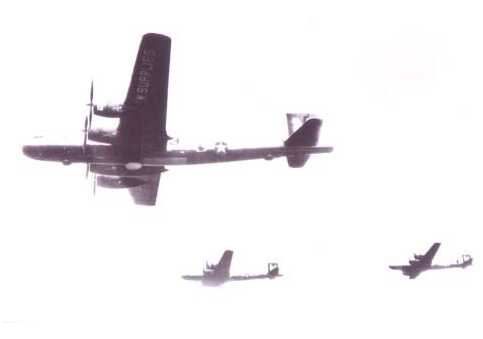
PHOTOGRAPH SHOWING AIRCRAFT MARKINGS OF B-29'S ENGAGED IN POW SUPPLY
OPERATIONS.
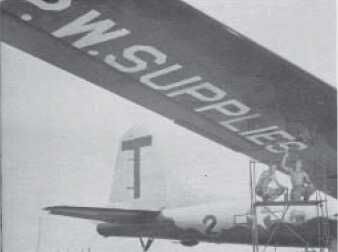
(4) It was planned to drop supplies in three increments of three-day, seven-day and ten-day supplies. A fourth increment of additional ten-day supplies was to be dropped if needed. The three-day supplies were to include juices, soups, clothing and medical supplies. The seven-day supplies were to include additional medical supplies and food of a more substantial nature. The ten-day supplies were to be almost all food, with some medical supplies. Leaflets with instructions concerning allocation and use of supplies also were to be dropped. Strike photographs were to be taken by each aircraft when conditions permitted.
(5) Normally, each aircraft was to carry supplies sufficient for 200 persons for the particular three, seven or ten-say period. However, for camps of 1000 or more population, aircraft were to be especially loaded for greater efficiency of packaging.
(6) Subject to forecast weather at and en route to the targets, it was planned to dispatch aircraft to all known camps in three phases, based on the supply increments referred to in Paragraph 4. The fourth phase of operations was to be contingent upon evacuation progress. It was anticipated that considerable overlapping of these phases would be experienced.
(7) The most perplexing problem in planning these operations was the determination of the location and population of the camps to be supplied. Until 27 August 1945, the only information upon which planning could be based was a compilation called the "Black List," issued by the General Headquarters, United States Army Forces, Pacific, and a Navy compilation issued in CINCPAC-CINCPOA Bulletin Number 113-45. These lists were incomplete and their accuracy was further reduced by the wholesale movement of Allied prisoners from the heavily bombed Japanese coastal areas in the last few months of the war. One of the surrender conditions imposed by the Allies was that the Japanese government mark clearly all prisoner of war and civilian internment camps and furnish the Allied Supreme Commander a complete list of the names, locations and populations of all camps. The first Japanese list, known as the "Yellow List," was made available to the Twentieth Air Force on 27 August. It contained 73 camps. There remained the task of verifying the location of the camps on the "Black List" upon which no additional information had been received. On August 29 aircraft of the 314th Bombardment Wing were dispatched to verify the location of camps on the Japanese home islands or Honshu, Shikoku and Kyushu, and on 31 August aircraft of the same Wing were dispatched on reconnaissance missions to Hainan Island, the Peking, Hong Kong and Shanghai areas of China, and the Mukden area of Manchuria. This reconnaissance verified the existence and location of 57 additional camps. Special requests and additional reports were expected to increase the list of camp locations as the operations progressed. (See Annex B for names and estimated population of camps to which missions were flown.)
(8) The Navy was notified of plans of these operations and agreed to furnish air-sea rescue facilities consisting of surface vessels on permanent stations along the routes to be flown.
(9) All Field orders for these missions were to be issued by the headquarters of the Wings engaged in these operations. This was necessary because of the nature of the missions. (See Annex F for a sample of a Wing Field Order.)
2. EXECUTION OF THE MISSIONS:
a. Missions Flown: From 27 August to 20 September, aircraft of the 58th, 73rd 313th, 314th and 315th Bombardment Wings flew 900 effective sorties against 158 prisoner of war and civilian internment camps. This included sorties flown to camps which were added to the lists after operations had begun. Although all five Wings participated in the operations, more than half of the effective sorties (52.4%) were flown by the 73rd Wing, based on Saipan. Ten sorties were staged through Okinawa. (See Annex E for more complete statistics.)
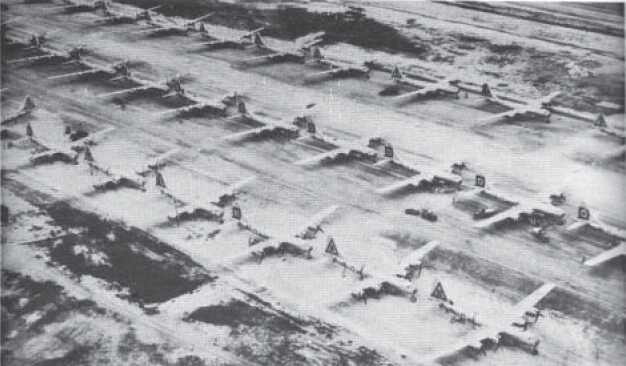
b. Aircraft Loading: A total of 4470 tons of supplies was dropped by aircraft on these missions. Loading of individual aircraft varied according to the need of the particular target. The number of bundles varied from 25 to 40 per aircraft. A breakdown of the average tonnage carried by individual aircraft of the different Wings revealed the following:
(1) 58th Wing - 3.76 tons per aircraft
(2) 73rd Wing - 5.05 tons per aircraft
(3) 313th Wing - 5.16 tons per aircraft
(4) 314th Wing - 4 tons per aircraft
(5) 315th Wing - 4.8 tons per aircraft
(For total figures on loading see Annex E.)
c. Altitude of Drops: The planned altitude for dropping, 500 to 1000 feet, proved too low for efficient operation of the cargo parachutes. Consequently, after the first three days of operations, all crews were briefed to drop at altitudes above 1000 feet to allow better functioning of parachutes and to avoid casualties among prisoner personnel and destruction of supply bundles. Dropping altitudes varied greatly, due largely to weather and terrain conditions.
d. Effect of Evacuation of Camps on Operations: Evacuation of prisoner of war camps by the U.S. Eighth Army, U.S. naval units and other agencies gradually reduced the task of supply during the course of operations. Although lack of information on evacuation progress caused some confusion in the first few days of the operation, the list of camps was reduced rapidly after 5 September. Each succeeding phase of the operation saw a marked decrease in the number of targets and the fourth phase included only a few camps.
e. Air-Sea Rescue: (See Annex C for Air-Sea Rescue Chart) Surface vessels were stationed at the following points during the period of these missions:
(1) Marianas to Iwo Jima: 1800N-14430E and 2145N-14245E.
(2) Iwo Jima to Honshu: 2800N-14050E; 3130N-14020E and 3140N-13920E.
(3) Okinawa to Honshu: 2725N-12908E; 2832N-13031E; 2938N-13154E; 3040N-13320E; 3154N-13447E; 3300-13614E and 3408N-13744E.
Two aircraft ditched on take-off. Of 23 crew members, 15 were rescued.
f. Navigation: Navigation to and from the targets was by individual aircraft, with flight routes being prescribed by the Wing headquarters.
g. Weather: Daily weather forecasts were furnished to each Wing and missions were planned by the Wings on basis of this information.
h. Aircraft and Personnel Losses: Eight aircraft were lost on these missions, with a total of 77 casualties. (See Annex E for a breakdown of these statistics.) One aircraft was accidentally shot down by Soviet forces over Korea (with all crew members rescued). Three were lost operationally and four were lost to unknown causes.
3. RESULTS: (See Annex D for strike photographs and assessment reports of these missions.) Missions were conducted against 169 prisoner of war and civilian internment camps during these operations. Upon 158 of these camps, one or more successful drops were made. All missions against 11 camps were unsuccessful, mainly because of the inability of crews to locate the camps from the coordinates provided. Of the camps upon which successful supply drops were made, 158 received a three-day supply drop, 128 received a seven-day supply drop and 91 received one or more ten-day supply drops. (See Annex A for maps of camp locations.)
(signed)
N. F. TWINING
Lieutenant General, N.S.A.
Commanding
ANNEX A - Maps of POW Camp Locations
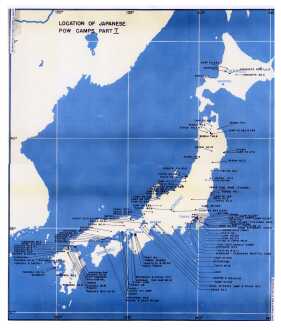
Camps in Japan targeted for supply drops
(click for 1MB enlargement)
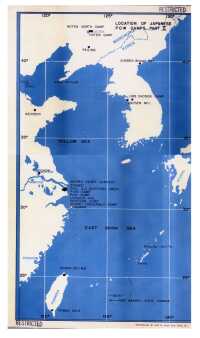
Camps in Korea and China targeted for supply drops
(click for 700Kb enlargement)
ANNEX B - Names and Population Estimates of POW Camps to which Missions were Conducted*
* Names of camps were taken from various compilations and conform to no
system.
| CAMP |
ESTIMATED
POPULATION |
|---|---|
| Niigata (Sub Camp No. 5) | 354 |
| Fukushima | 141 |
| Iwake Coal Mine (Yuwake) | 1000 |
| Naoetsu (Niigata Ken) | 200 |
| Ohashi | 600 |
| Omori (Main Camp) | 611 |
| Takadanobaba | 3300 |
| Shinagawa (Hospital Camp) | 297 |
| Urawa (Rescue efforts, C.A. Robinson) |
56 |
| Shibaura Docks | 100 |
| Chiba | 100 |
| Minato Ku | 400 |
| Umeda Bunsho | 350 |
| Aioshi | 300 |
| Himeji (Osaka Division Camp) | 500 |
| Narumi | 748 |
| Maisuri | 3000 |
| Sakai Prison | 4000 |
| Zentsuji | 468 |
| Sub Camp No. 6 (Omine) | 700 |
| Sub Camp No. 8 | 400 |
| Sub Camp No. 10 (Higashi Misome) | 2165 |
| Innoshima Is. | 212 |
| Mukaijima | 83 |
| Moji Hospital | 233 |
| Omuta | 300 |
| Nagasaki | 42 |
| Yahata | 100 |
| Hoten Camp | 2234 |
| Hoten North Camp | 261 |
| Peiling | 1000 |
| Pootung Camp | 400 |
| Chapei (Assembly Camp) | 200 |
| Lungwha | 1000 |
| Sacred Heart Convent | 350 |
| Zikawei | 200 |
| Civil A.C. (Eastern Area) | 200 |
| Yonchow | 400 |
| Weihsein | 1522 |
| Osaka No. 9 | 200-400 |
| Osaka No. 10 | 200-400 |
| Osaka No. 11 | 200-400 |
| Osaka Branch No. 1 | 200-400 |
| Hiroshima No. 1 | 200-400 |
| Camp No. 284 | 200-400 |
| Camp No. 285 | 200-400 |
| Camp No. 292 | 200-400 |
| Camp No. 293 | 200-400 |
| Camp No. 295 | 200-400 |
| Camp No. 296 | 200-400 |
| Camp No. 297 | 200-400 |
| Camp No. 298 | 200-400 |
| POW Camp | 200 |
| POW Camp | 400 |
| Lincoln Ave. | 200 |
| Mithuhsima | Unknown |
| Hq. Tokyo Camps | 450 |
| Hq. Tokyo Branch Camps | 137 |
| Tokyo No. 1 | 205 |
| Tokyo No. 3 | 101 |
| Tokyo No. 4 | 699 |
| Tokyo No. 5 | 185 |
| Tokyo No. 6 | Unknown |
| Tokyo No. 8 | 294 |
| Tokyo Branch No. 9 | 214 |
| Tokyo No. 10 | 257 |
| Tokyo No. 12 | 310 |
| Tokyo No. 13 | 544 |
| Tokyo No. 14 | 155 |
| Tokyo No. 15 | 700 |
| Tokyo No. 16 | 292 |
| Tokyo No. 17 | 50 |
| Kanagawa Camp | 47 |
| Kanagawa No. 2 | 19 |
| Aichi Camp | 21 |
| Keishoho No. 2 | 36 |
| Sendai No. 1 | 569 |
| Sendai No. 2 | 246 |
| Sendai No. 3 | 284 |
| Sendai No. 4 | 778 |
| Sendai No. 6 | 546 |
| Sendai No. 7 | 292 |
| Sendai No. 8 | 344 |
| Sendai No. 9 | 273 |
| Sendai No. 10 | 300 |
| Sendai No. 11 | 196 |
| Miyagi No. 1 | 35 |
| Osaka Hq. | 851 |
| Osaka No. 1 | 400 |
| Osaka No. 2 | 490 |
| Osaka No. 3 | 843 |
| Osaka No. 4 | 440 |
| Osaka No. 5 | 400 |
| Osaka No. 6 | 298 |
| Osaka No. 7 | 200 |
| Osaka No. 8 | 200 |
| Hyogo Camp | 163 |
| Hiroshima No. 2 | 612 |
| Hiroshima No. 3 | 200 |
| Hiroshima Branch No. 1 | 176 |
| Hiroshima Branch No. 2 | 182 |
| Hiroshima Branch No. 4 | 473 |
| Hiroshima Branch No. 5 | 283 |
| Hiroshima Branch No. 6 | 482 |
| Fukushima | 139 |
| Hiroshima Camp | 44 |
| Saitama Camp | 36 |
| Fukuoka No. 1 | 399 |
| Fukuoka No. 21 | 597 |
| Fukuoka No. 22 | 303 |
| Fukuoka No. 23 | 196 |
| Fukuoka No. 24 | 268 |
| Fukuoka No. 25 | 396 |
| Fukuoka No. 27 | 689 |
| Fukuoka Branch No. 8 | 689 |
| Fukuoka Branch No. 9 | 550 |
| Fukuoka Branch No. 11 | 573 |
| Fukuoka Branch No. 12 | 793 |
| Nagasaki Camp | 41 |
| Hq. Chosen Camp | 170 |
| Chosen No. 1 | 354 [actual 156] |
| Chosen Branch No. 1 | 156 [actual 354] |
| Taiwan No. 1 | 1250 |
| Taiwan No. 4 | 323 |
| Taiwan No. 6 | Unknown |
| Hakodate | 393 |
| Hokkaido Camp | 25 |
| Hakodate No. 1 | 509 |
| Hakodate No. 2 | 281 |
| Hakodate No. 3 | 310 |
| Hakodate No. 4 | 83 |
| Iwataki | 50 |
| Camp No. 266 (Fukuyama Ward) | 200 |
| Camp No. 267 | 200 |
| Camp No. 268 | 200 |
| Camp No. 270 | 200 |
| Camp No. 271 | 200 |
| Camp No. 276 | 200 |
| Camp No. 277 | 800 |
| Fort Bayard | 100 |
| Himeji | 200 |
| Kawasaki (Sub Camp No. 25) | 200 |
| Ofuna | 200 |
| Sekiguchi | 400 |
| Camp No. 280 | 400 |
| Camp No. 281 | 200 |
| Camp No. 282 | 100 |
| Camp No. 283 | 100 |
| Camp No. 263 | 100 |
| Camp No. 266 | 100 |
| Fukuoka No. 2 | 500 |
| Fukuoka No. 3 | 1200 |
| Fukuoka No. 4 | 300 |
| Fukuoka No. 14 | 200 |
| Fukuoka No. 17 | 1700 |
| Yokkaichi | Unknown |
| Oita-Hagiwara | 400 |
| Fukuoka-Najima | 100 |
| Niihama | 5 |
| Karashima | Unknown |
| Noda Internee Camp | Unknown |
| Camp No. 302 | 150 |
| Camp No. 304 | Unknown |
| Camp No. 307 (Notogawa) | 100 |
| Camp No. 312 | 44 |
| Miyoshi | Unknown |
| Tobata | Unknown |
| Fukuoka Najima [duplicate?] | 100 |
| 69,000 (Estimated) |
ANNEX E - Statistical Summary
| Final Statistics on POW Camp Project* | ||||||||||
|---|---|---|---|---|---|---|---|---|---|---|
| Wing | A/C Sched. |
A/C Airbrn |
Eff. Sorties |
Non- Eff. Sorties |
Tons Loaded |
Tons Drop- ped |
Tons Jet- tisoned |
Tons Re- turned |
A/C Lost |
Casual- ties |
| 58 |
76 |
75 |
60 |
15 |
359 |
282 |
10 |
67 |
2 |
12 |
| 73 |
581 |
580 |
472 |
108 |
2932 |
2370 |
99.3 |
463 |
4 |
39 |
| 313 |
231 |
222 |
190 |
32 |
1192 |
1018 |
11.3 |
163 |
1 |
14 |
| 314 |
62 |
62 |
61 |
1 |
248 |
244 |
10 |
4 |
0 |
0 |
| 315 |
126 |
127 |
117 |
10 |
610 |
556 |
0 |
54 |
1 |
12 |
| 1076 |
1066 |
900 |
166 |
5341 |
4470 |
120.6 |
751 |
8 |
77 |
|
| * Prepared by 33rd Statistical Control Unit. | ||||||||||